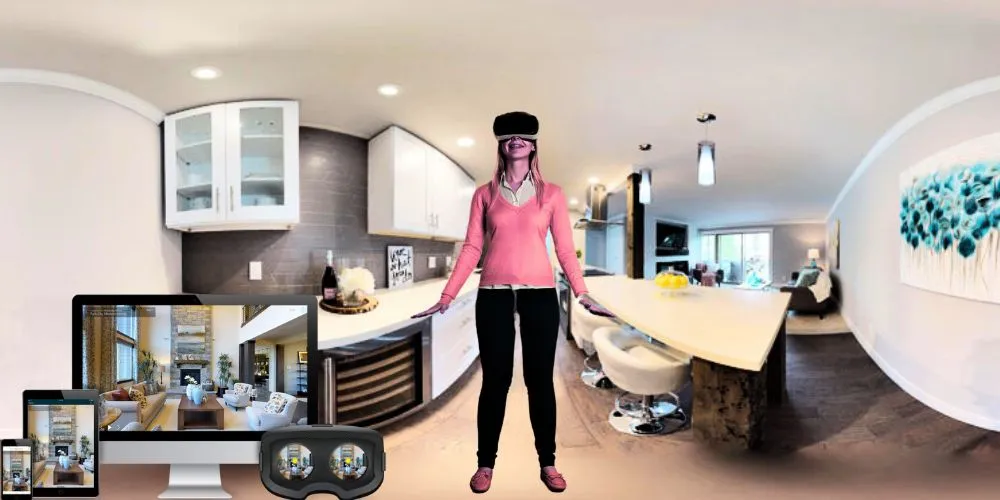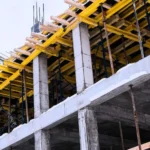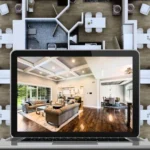Virtual Reality (VR) technologies have emerged as a game-changing innovation in today’s dynamic real estate market, fundamentally transforming how individuals search for and experience properties. As we navigate an increasingly digital world, these immersive tours offer a unique and engaging means of exploring homes, apartments, and commercial spaces. This comprehensive article dives deep into the realm of virtual reality property tours, exploring their foundational principles, discussing their profound impact on the real estate landscape, and highlighting the challenges and promising opportunities that lie on the horizon.
What Are Virtual Reality Property Tours?
Virtual Reality Property Tours, often called VR property tours, harness advanced digital technology to craft immersive, 3D virtual experiences of real estate properties. These tours enable users to seamlessly navigate and explore properties from the comfort of their own homes or real estate offices, delivering a detailed and interactive glimpse into space.
By simply donning a VR headset or accessing the tour through a web browser, individuals can virtually stroll through rooms, scrutinize details, and cultivate a genuine sense of the property’s layout and ambiance.
How Do VR Property Tours Work?
The creation of virtual reality property tours involves several pivotal steps.
3D Scanning and Modeling
Commencing the process, the property undergoes a meticulous scan utilizing specialized 3D scanning equipment. This initial step captures the property’s physical dimensions, layout, and intricate details.
Creating the Virtual Environment
The captured data serves as the building blocks for the digital replication of the property, culminating in a comprehensive 3D model. This model encompasses both interior and exterior spaces, furnishings, and any unique features the property may possess.
Interactive Features
Going beyond mere static 3D models, virtual reality property tours incorporate interactive elements. Users can navigate space, inspect different angles, and even zoom in to examine areas of interest closely.
VR Hardware and Software
Users require compatible hardware, such as VR headsets or VR-enabled smartphones, to partake in a Virtual Reality Property Tour. Software applications or platforms are utilized to access and explore these immersive tours.
Engagement
Armed with the necessary hardware and software, users dive into the VR property tour, experiencing the space as if they were physically present. This immersion offers a comprehensive view of the property’s layout, design, and overall atmosphere.
Advantages of VR Property Tours
The embrace of virtual reality property tours delivers various benefits, effectively reshaping the real estate market.
Realistic Exploration
VR property tours provide unparalleled realism, enabling users to explore properties as if they were physically present. This heightened realism enhances decision-making by providing an authentic sense of space and ambiance, fostering a stronger emotional connection with the property.
Convenience
Prospective buyers and renters can now explore properties at their leisure, eliminating the need for frequent physical visits. This convenience is particularly valuable for international buyers or those with limited mobility, saving them time and effort.
Time Savings
Virtual reality property tours are time-efficient for buyers and sellers. Buyers can quickly filter out properties that do not align with their criteria, while sellers can focus on more serious inquiries, streamlining the process for all parties involved.
Increased Engagement
The immersive nature of virtual reality property tours leads to heightened engagement. Users can thoroughly evaluate the property, leading to more informed decision-making and a higher likelihood of making property inquiries. This increased engagement enhances the efficiency of the real estate transaction process.
Global Reach
Virtual tours extend the reach of property listings to a global audience. This broader exposure attracts potential buyers or renters from anywhere worldwide, transcending geographical boundaries and expanding the market.
Applications of VR Property Tours
Virtual reality property tours are applicable across various real estate market segments, demonstrating their adaptability and relevance in diverse scenarios.
Residential Real Estate
For homes and apartments, VR property tours offer an immersive experience that allows users to envision living in the space. This is especially valuable for remote or international buyers who may not have the opportunity for physical visits. Additionally, it expedites the decision-making process for local buyers.
Commercial Real Estate
Virtual reality property tours are instrumental in showcasing office spaces, retail properties, and industrial facilities. Businesses can efficiently evaluate properties without needing multiple site visits, making the search and leasing process more streamlined.
Vacation Rentals
Travelers can explore vacation properties in detail, helping them make well-informed decisions about booking accommodations. VR property tours accurately represent the vacation rental, reducing the risk of unpleasant surprises upon arrival.
New Developments
Real estate developers utilize virtual reality property tours to showcase planned developments or off-plan properties. This provides potential buyers with a preview of the final product, aiding pre-sales and attracting investors or early adopters.
Challenges and Future Directions
Despite their tremendous potential, virtual reality property tours face challenges to widespread adoption.
Technology Accessibility
The accessibility of VR technology remains a challenge. VR headsets and compatible devices can be costly, limiting the audience that can readily benefit from virtual tours. However, as technology becomes more affordable and accessible, this barrier is gradually diminishing.
Content Creation Costs
Creating high-quality VR property tours involves 3D scanning, modeling, and software development costs. Smaller real estate agencies or individual sellers may find these costs prohibitive. However, collaborative efforts and technological advancements are driving down these expenses over time.
User Experience
While virtual reality property tours offer immersive experiences, they may not fully replace physical visits for some buyers who prefer tactile exploration. Striking a balance between virtual tours and physical visits will be crucial in meeting diverse buyer preferences.
Internet Speed
To access VR property tours online, users require high-speed internet connections. In areas with limited connectivity or slow internet speeds, the experience may be compromised. Improvements in internet infrastructure will contribute to addressing this challenge.
Privacy Concerns
Virtual reality property tours capture detailed images of properties, which may raise privacy concerns for current occupants. Ensuring the responsible use of VR tours and obtaining consent from occupants is essential to address these privacy concerns effectively.
Conclusion
Virtual reality property tours have ushered in a new era of real estate exploration, offering an immersive and convenient means for buyers and renters to experience properties. Despite challenges related to technology accessibility and content creation costs, the benefits of VR property tours are revolutionizing the industry. As technology advances and VR becomes more accessible, we can anticipate even greater integration of virtual reality experiences into the real estate market.
Virtual tours are poised to become a standard tool in property listings, providing a richer and more informative experience for potential buyers and renters. Virtual reality property tours represent a potent fusion of technology and real estate, and their impact on the industry is set to grow exponentially in the coming years, fundamentally altering how we discover and engage with our future homes and properties.












